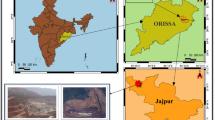Abstract
The purpose of blasting operations is rock fragmentation. Blasting is a key component in the overall rock fragmentation system - the first element of the ore extraction process. It provides appropriate rock material granulation or size that is suitable for loading and transportation. However, in spite of many advantages explosives have, their usage may cause environmental problem such as seismic vibration. One of the solutions to this particular problem may be application of an artificial screen as a barrier to the seismic wave path. The results of experimental research on the artificial screen concept, its characteristics and role in attenuation of seismic effects generated by blasting are presented. The experiment is based on two physical phenomena: (1) the size and degree of discontinuity and (2) the reflection and refraction of seismic waves. More than 1,500 laboratory measurements were conducted with different combinations of screen sizes, positions of the screen to blasting source, and intensities of blasting impulses. The results of the study show reduction of generated vibrations up to 58% by employment of artificial screens.













Similar content being viewed by others
References
ABEM Instrument AB (2006) VIBRALOC, http://www.abem.se/products/vibraloc/vibraloc.php, Sweden
Bhandari S (1997) Engineering rock blasting operations. A.A. Balkema 375
Daehnke A, Rossmanith HP (1997) Reflection and refraction of plane stress waves at interfaces modeling various rock joint. Fragblast 1(2):111–231
Fourney WL, Dick RD, Fordyce DF, Weaver TA (1997) Effects of open gaps on particle velocity measurements. Rock Mech Rock Eng 30(2):95–111
Kipp ME, Lawrence RJ (1982) WONDY V – A one-dimensional finite-difference wave-propagation code. Sandia National Laboratories Report, SAND81–0930
Olofsson SO (1997) Applied explosive technology for construction and mining. Aplex: 304
Raina AK, Haldar A, Chakraborty AK, Choudhury PB, Bandyopadhyay RM (2004) Human response to blast-induced vibration and air-overpressure: an Indian scenario. Bull Eng Geol Environ 63:209–214
Rossmanith HP, Hochholdinger-Arsic V, Uenishi K (2005) Understanding size and boundary effects in scaled model blast – plane problems. Int J Blasting Fragment 9(2):93–125
Rustan A (1998) Rock blasting terms and symbols. A.A. Balkema:193
Simha KRY (1996) Effect of open joint stress wave propagation. Fragblast 5:81–86
Singh TN, Singh V (2005) An intelligent approach to prediction and control ground vibration in mines. Geotech Geol Eng 23:249–262
Siskind D (2000) Vibrations from blasting. International Society of Explosives Engineers:120
Valdivia C, Vega M, Scherpenisse CR, Adamson WR (2003) Vibration simulation method to control stability in the northeast corner of escondia mine. Int J Blasting Fragment 7(2):63–78
Voloh АС (1989) Основы управления действием взрыва с помощью екранирования (Basics of an explosive management using screens). Наука Москва:223
Worsey PN (1986) Understanding vibrations from multihole blasts using short delay periods. J Explosives Eng 3(6):8–25
Author information
Authors and Affiliations
Corresponding author
Rights and permissions
About this article
Cite this article
Bogunovic, D., Kecojevic, V. Artificial screen for reducing seismic vibration generated by blasting. Environ Geol 53, 517–525 (2007). https://doi.org/10.1007/s00254-007-0663-4
Received:
Accepted:
Published:
Issue Date:
DOI: https://doi.org/10.1007/s00254-007-0663-4




